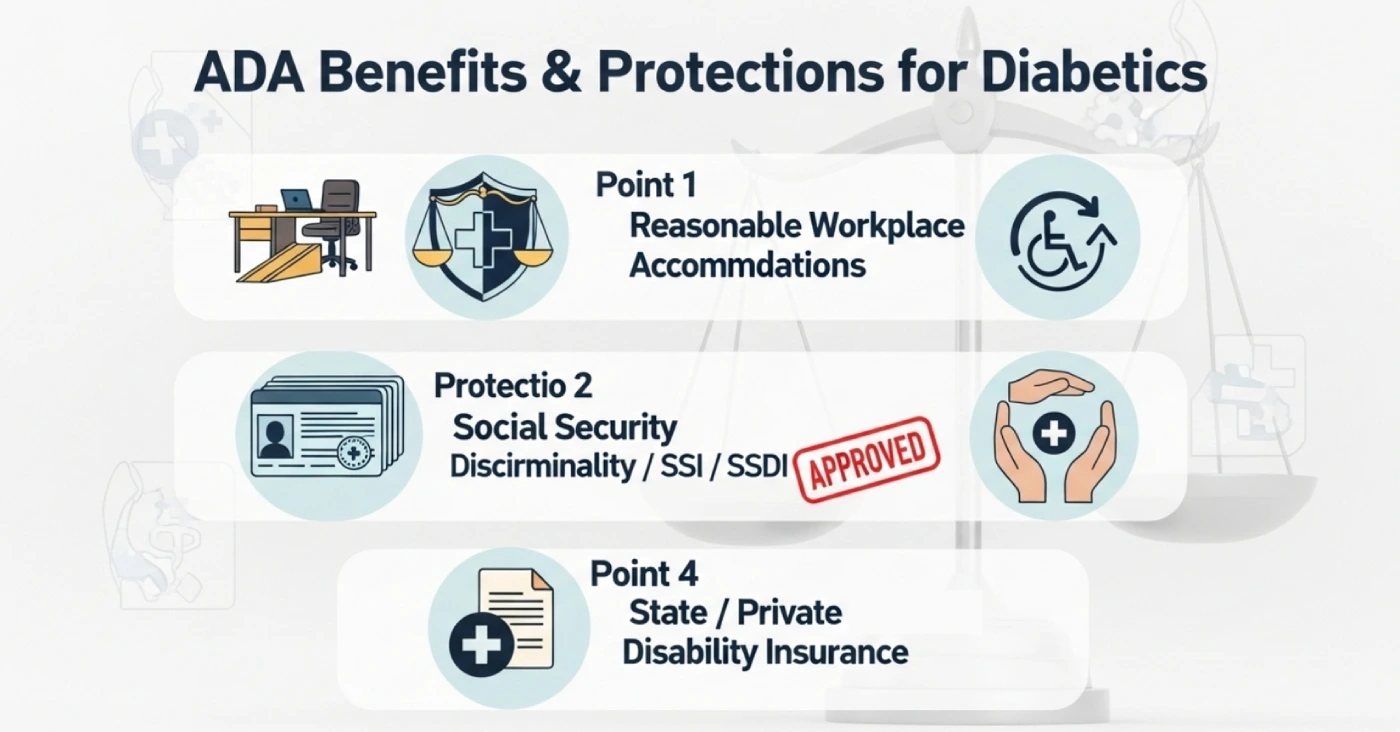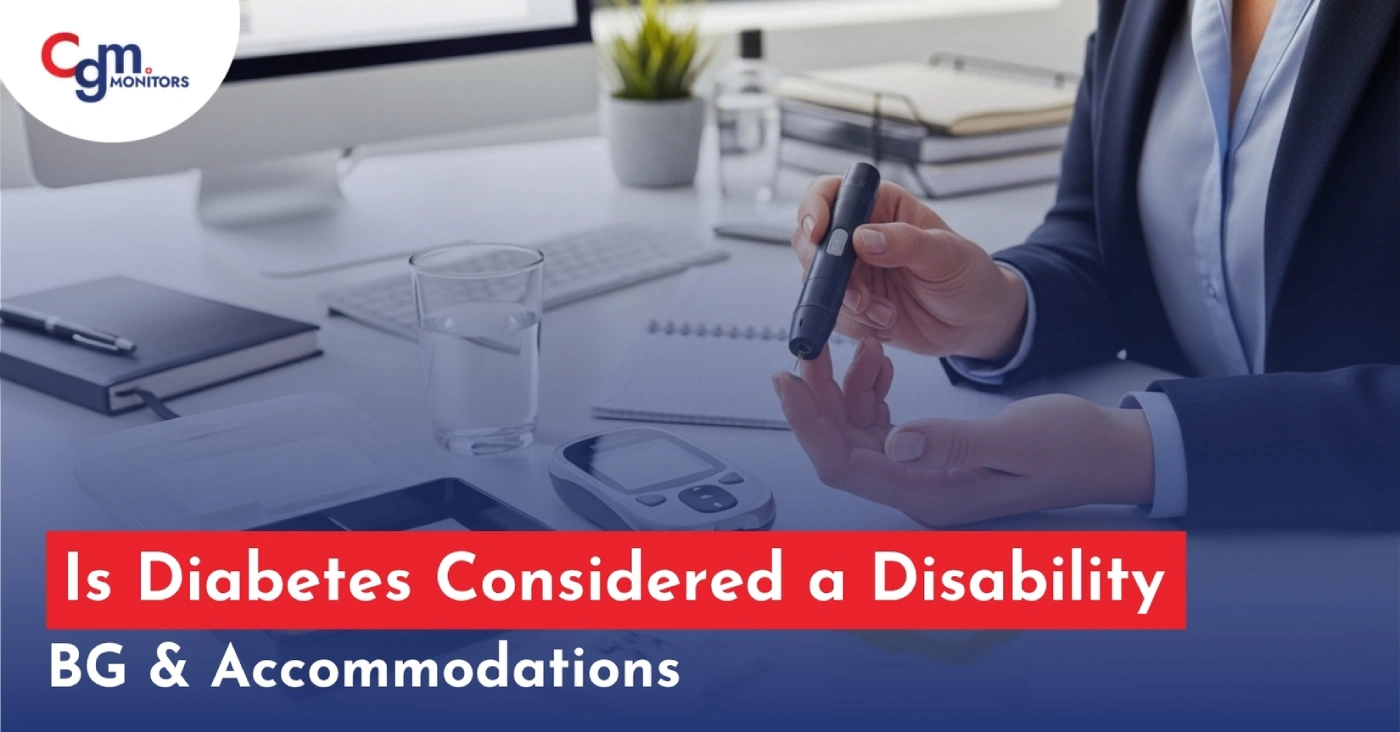Table of content
- Type 1 vs Type 2 Diabetes: Disability Considerations
- When Is Diabetes Considered a Disability?
- Diabetes Benefits Under SSI and SSDI
- Disability Benefits for People with Diabetes Under ADA
- How Social Security Administration Evaluates diabetes for disability benefits
- Do You need to disclose your condition?
- Can Diabetes Be Reversed?
- Conclusion
- Frequently Asked Questions
The law defines a “disability” not by visible impairment but by whether a condition substantially limits a major life activity (e.g. endocrine functioning, eating, working). So, ‘Is Diabetes Considered a Disability?’, here is a bit of explanation to this question – diabetes is considered an impairment of the endocrine system, one of the body’s major bodily functions.
Even when managed well, diabetes imposes burdens such as monitoring, hypoglycemia, treatment side effects, risk of complications, and more. The ADA (post-2008) broadened the definition so that mitigating measures (like insulin, pumps) aren’t always allowed to “undo” the impairment in legal analysis.
So yes — diabetes can be a disability in legal terms, even if you do daily tasks like a non-diabetic does.
Type 1 vs Type 2 Diabetes: Disability Considerations
- Type 1 Diabetes Disability: Since Type 1 diabetes often requires daily insulin injections, monitoring, and lifestyle adjustments, it is widely recognized as a disability. People with Type 1 may qualify for workplace accommodations or even Social Security Disability benefits if complications arise.
- Is Type 2 Diabetes Considered a Disability? Type 2 diabetes is sometimes more variable in its severity. Individuals with well-managed Type 2 diabetes may not experience daily life limitations. However, if complications such as neuropathy, kidney disease, or vision impairment develop, Type 2 diabetes may also be recognized as a disability.
When Is Diabetes Considered a Disability?
Diabetes may be considered a disability under the following circumstances:
- Severe Hypoglycemia or Hyperglycemia: If blood sugar fluctuations significantly affect your ability to work, drive, or perform daily activities, you may qualify for disability.
- Complications from Diabetes: Long-term effects like kidney disease, neuropathy, vision problems, or cardiovascular issues can elevate diabetes to a disability status.
- Workplace Limitations: If diabetes management interferes with your work tasks or attendance, employers must provide reasonable accommodations.
Diabetes Benefits Under SSI and SSDI
ADA states that diabetics, both type 1 and type 2, may be eligible for getting Social Security Disability Insurance (SSDI) or Supplemental Security Income (SSI), only under serious diabetic conditions.
- Under the Americans with Disabilities Act (ADA), diabetes is considered a disability for both type 1 and type 2 — people with either type are protected from discrimination.
- Diabetics have protections and rights at school, workplace, and public places as well.
- ADA restricts when employers can ask about your medical condition (before offer, etc.)
If covered;
At Workplace: Employers must provide reasonable accommodations (unless undue burden). For example, breaks to test blood sugar, access to food/fluids, adjusting schedule for medical appointments.
At Schools: Trained staff should be available (even during trips and any other school-organised activities) for monitoring blood sugar and administering insulin or other medications. While the self-trained students be allowed to treat their diabetes at all times and at any place.
In Public Places: According to the Transportation Security Administration, travelers are allowed to carry their diabetic supplies with them, however, they should clearly declare these items as their diabetes related supplies, e.g., strips, equipment such as; continuous glucose monitoring sensors (CGMs) or blood glucose monitors (BGMs), and even liquids are allowed to be carried.
Disability Benefits for People with Diabetes Under ADA
The following are some of the accommodations and benefits for people living with diabetes:
1. Reasonable workplace accommodations
- Space/time for glucose monitoring, insulin injections, meals/snacks
- Flexibility for medical appointments or treatment
- Adjusted break schedules or job duties
- Leave as an accommodation when needed
2. Protection from discrimination
- Cannot be refused job or promotion simply because of your diabetes
- Must be treated as a “qualified individual with a disability”
3. Social Security Disability / SSI / SSDI
- Disability benefits are monetary, not just anti-discrimination.
- Diabetes must reach severity threshold.
4. State / private disability insurance
- Some employer or private plans may provide short-term or long-term disability benefits if you meet plan criteria; these differ from ADA or Social Security.
Still pricking fingers to check your glucose?
CGMs like Freestyle Libre 2 Plus sensors are making it easy for users to monitor their glucose 24/7 without the need of multiple pricks, and the best part, these CGMs are compatible with automatic insulin delivery (AID) systems as well.
Order yours today from CGM Monitors by claiming your insurance or by simply using your credit/debit card, and receive your supplies without any delivery costs (within the USA) at your door.

How Social Security Administration Evaluates diabetes for disability benefits
- SSA uses SSR 14-2p and the Blue Book Endocrine Listings (Section 9.00) as guidance.
- There is no automatic grant just for having diabetes — SSA looks at severity, complications, evidence of impairment, and ability to work.
- SSA considers specific complications (if present) from diabetes, such as:
- Neuropathy (nerve damage)
- Retinopathy/vision loss
- Kidney disease
- Cardiovascular disease
- Skin ulcers or infections that don’t heal
- Amputations
- Frequent hospitalizations
- Hypoglycemia disabling episodes
- Other coexisting conditions (obesity, hypertension etc.)
These complications can push your condition past “severe” threshold.
Do You need to disclose your condition?
- Under ADA, you do not have to disclose your diabetes at the interview stage (before a job offer). Employer may not ask about it.
- After you have the job (or a conditional offer), disclosure may be needed to request accommodations.
- Disclosure is often strategic: you can reveal in writing when asking for accommodation.
- Employers must keep medical information confidential.
- If you never ask for accommodations, the employer may not even know.
Can Diabetes Be Reversed?
A common question is: can you get rid of diabetes? While Type 1 diabetes is not reversible due to autoimmune destruction of insulin-producing cells, Type 2 diabetes may be managed or even reversed through intensive lifestyle changes, weight management, and medication.
Conclusion
Substantially limiting your endocrine and attacking pancreatic system, diabetes is a disability. However, on one side, this disability does not restrict you from living a normal lifestyle, including driving, sports, even contact sports, and more. And on the other side, anti-discrimination laws do apply to people with diabetes (depending on the conditions), allowing them to easily treat their condition on their job, while at school, and even on public spots like airport (more info on carrying supplies on airports has been explained above).
Frequently Asked Questions
Is diabetes covered under the American Disabilities Act if my symptoms are mild?
It depends whether your impairment (considering complications or limitations) substantially limits a major life activity.
Do I qualify for disability with diabetes?
You may qualify if your diabetes substantially limits your daily activities or leads to severe complications such as neuropathy, kidney disease, or vision impairment. Each case is evaluated individually by the Social Security Administration (SSA).
What benefits is a diabetic entitled to?
Depending on severity, you may be eligible for Social Security Disability Insurance (SSDI), Supplemental Security Income (SSI), workplace accommodations under the ADA, and sometimes state-specific health or financial benefits.
Do you get money from the government if you have diabetes?
Yes, individuals with severe diabetes that qualifies as a disability can receive SSDI or SSI benefits, which provide financial support while managing medical needs.
How much is federal disability pay?
Federal disability payments vary. SSI may provide up to around $900–$1,000 per month for individuals, while SSDI depends on lifetime earnings and can be higher.
Is it harder to get SSI or SSDI?
SSI is means-tested and focuses on low-income individuals, while SSDI is based on work history. SSDI approval can be easier if you have documented work credits but medical evidence is crucial for both.
Can you get disability for diabetes via SSA / SSDI?
Yes, but only if your diabetes and its complications are severe enough to meet SSA standards, e.g., Neuropathy, retinopathy, kidney disease, cardio, and more.
Does diabetes disability ADA protection automatically apply at work?
Not, it does not apply automatically, you must show your diabetes, even in written form when applicable and request accommodations.
Is hypoglycemia considered a disability?
Yes, severe hypoglycemia that affects your ability to perform daily activities can be recognized as a disability. Individuals may qualify for accommodations at work or school.
Can type 2 diabetes become type 1??
No, Type 2 diabetes cannot turn into Type 1. However, some people with Type 2 diabetes may eventually require insulin therapy due to beta-cell exhaustion.
Disclaimer: This blog is for informational purposes only and does not constitute medical, legal, or professional advice. While we strive for accuracy, errors or omissions may occur.
Some images in this blog may be AI-generated or for illustrative purposes only.







Write a comment
Your email address will not be published. All fields are required